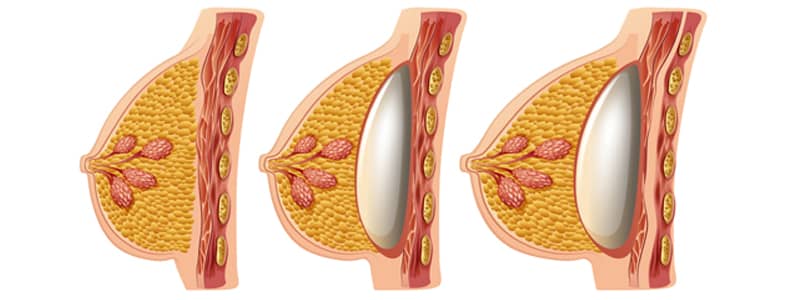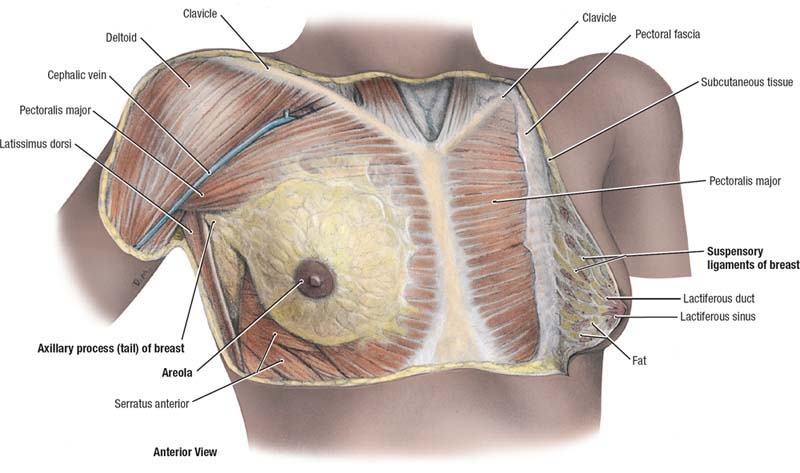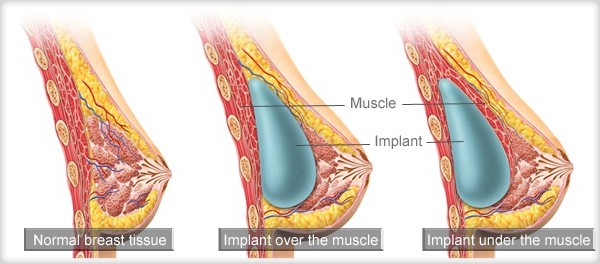
The 2 Different Implant Placements
Let’s take a look at each of these to understand better why your plastic surgeon might recommend one placement over another.
Completely Submuscular
This is normally reserved for the placement of a tissue expander in breast reconstruction. What this implies is that chest muscles entirely cover the implant. Both the pectoralis major and serratus anterior muscles are elevated off the chest wall to entirely enclose the implant.
The reason to choose this approach is that skin integrity is often compromised in a mastectomy, and there is a high risk of skin loss and implant exposure. If this occurs in breast reconstruction, it normally leads to removing the implant and the need to start all over again. The underlying muscle is healthy and vascular; this may help preserve the implant if the skin fails to heal.
This approach is rarely used in cosmetic breast augmentation. The aesthetic outcome of this may be compromised since the implant can appear too high and out of balance within the breasts.

Image 1: Pectoralis Anatomy
Subglandular
This implant placement is the second most common in the US. Space is located above the chest muscle layer but immediately beneath the breast itself. It allows the implant’s proper location immediately behind the breast, and there are no restrictions related to the underlying muscle anatomy.
This placement provides the most direct impact of the implant on the breast to slightly elevate the nipple and areola without a lift. There is also no muscle-related distortion of the underlying implant that is frequently termed as animation deformity, where the implant can move with contraction of the pectorals muscle. Finally, this is the least painful placement since the muscle is not manipulated, which is usually the result of most postoperative pain.
The boon that is usually associated with this approach is that the implant is potentially more visible since the pectoralis muscle does not cover the implant. This results in a higher risk of implant rippling seen through the skin. Thus, the ideal candidates for this approach have some degree of preexisting breast tissue to help hide the implant.
Additionally, the incidence of capsular contracture is significantly higher with this placement location. As capsular contracture is one of the most challenging aspects of breast augmentation surgery, this risk alone is enough to avoid this approach in most women.

Image: Implant location
Subpectoral
This is the most common approach used for breast augmentation by plastic surgeons. It is also frequently associated with the dual plane technique.
A dual-plane surgical technique is an approach that separates the breast tissue from the pectoralis muscle but still keeps the implant largely in a submuscular position. The implant resides in a “dual plane” where the pectorals cover the top two-thirds, and the bottom third is covered by the breast tissue alone. This allows for the possibility of improvement in breast asymmetry and can result in a mild enhancement of a lift seen at the nipple and areola.
The major benefit of a breast implant’s submuscular placement is that it recruits more “soft tissue” to help hide or camouflage the underlying implants making the result more “natural” with less of a risk for visible rippling. In addition to this obvious benefit, the risk of capsular contracture is threefold less with this approach. This is significant and provides a more long-lasting, reliable result for most women. Finally, radiologists are more easily read mammograms as there is not a risk of the implant obscuring breast tissue hidden beneath it while remaining over the muscle layer.
In a subpectoral approach, all of the breast tissue sits above the muscle or implant itself. However, some negative aspects still exist with this approach. Firstly, the muscle’s elevation during surgery will frequently lead to more pain in the early aspect of your recovery. This is temporary but to be expected. Also, there is a risk for animation deformity where the breast or implant will move with the pectoralis muscle contraction. This does not happen to most women but is more significant versus a subglandular approach. While exercising or contracting the pectoralis, the implant can move, and women may find it unfavorable.
Choosing the best implant placement for you
When choosing the best location for the breast implant, you must consider this to compromise different techniques with individual pros and cons. This should be individualized with both the patient and surgeon after a lengthy discussion about your specific options regarding your anatomy, desires, and risk tolerance.
Fortunately, breast augmentation is a very successful surgery and one with many happy patients performed by a Board-Certified Plastic Surgeon. To see if you are a candidate for breast enhancement surgery, contact our San Diego office at 858-638-9800 to schedule your in-person consultation.
*The content in this blog is developed to spread the awareness towards plastic surgery. Our blog is not intended to serve as a replacement for an actual in-office consultation with Dr. Marin. As such, the information within this blog reflects the unique cases of our individual patients.